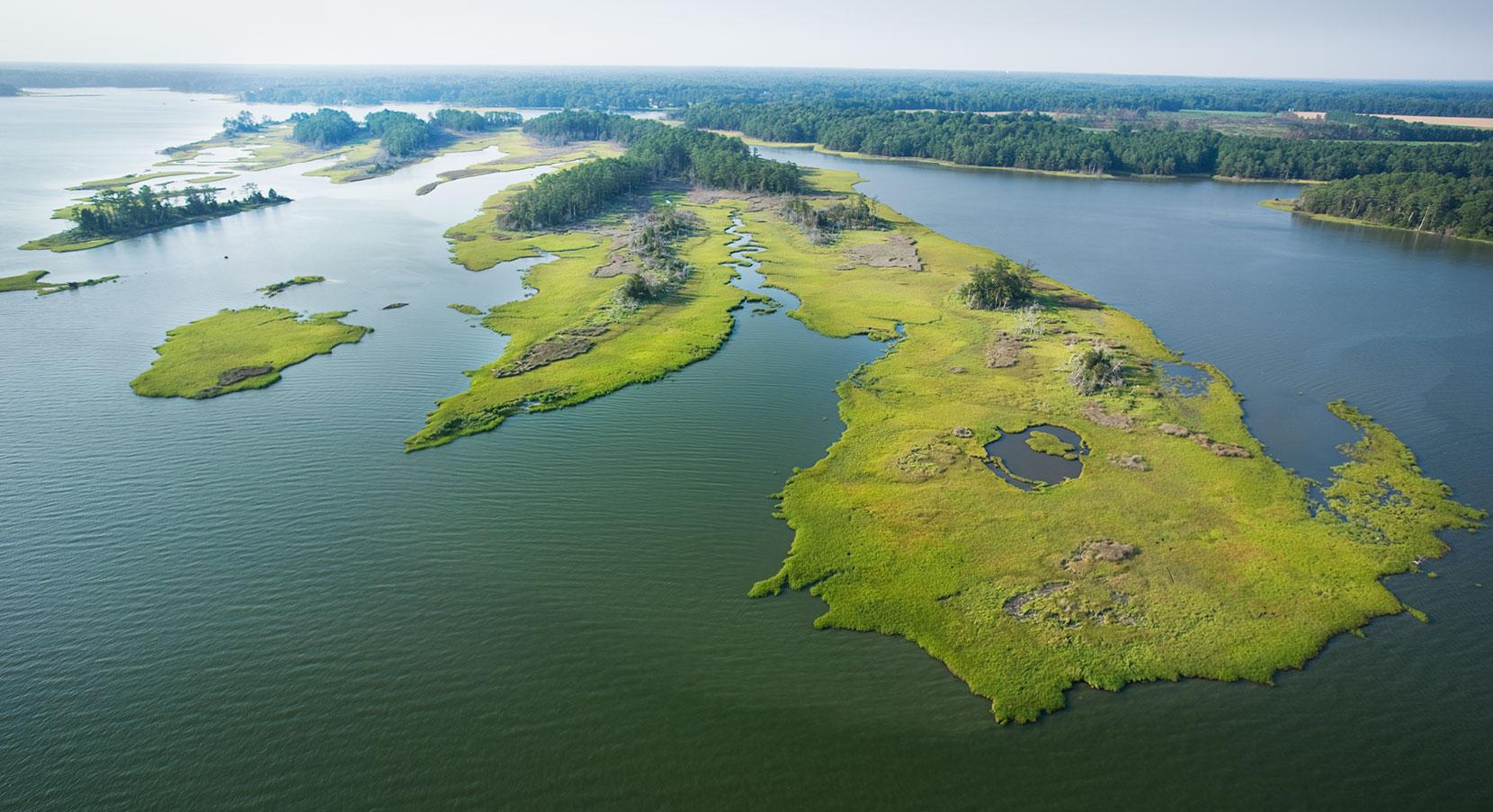“We Know How To Do This.”
On April 1, SELC’s Founder Rick Middleton will retire after 33 years, passing the torch to a new executive director, Jeff Gleason. On the eve of this important transition, Rick reflects back on how SELC became the powerhouse that it is today, and what gives him confidence about the challenges lying ahead.
Although he admits it would have been impossible to predict when he started Southern Environmental Law Center in 1986, Rick Middleton maintains that SELC, in its present form, is exactly the right organization, in just the right place, at precisely the right moment. “Because of its size, expertise, and capacity, SELC is far and away the best-situated organization in the country to deal with the biggest environmental issues facing our region.”
He lists a few: Global warming and climate change, population growth and development pressure, offshore drilling, unprecedented Trump administration attacks on even the most fundamental environmental safeguards.
Rick muses, “It’s almost as if someone wrote a script 30 years ago, imagining what the future would be like and laying out a blueprint for the organization that could deal with it. But,” he says with a laugh, “of course, I had no idea.”

Combining Heart and Mind
But, characteristically, Rick did have very definite ideas about what principles would guide the organization he wanted to create. The first was the notion of stewardship and love of place.
“I probably fall into the category of appreciating nature more than the average person,” he says. But Rick also knew that most southerners share a strong affinity with the landscape around them, and the places where they go to enjoy the outdoors. He knew firsthand that the South abounds in special places of heart-stopping beauty and ecological significance, which are largely unknown or unappreciated by people in other parts of the country. His hypothesis: if our special places were to be saved, it was up to us southerners to do it. “I’ve got a very strong sense of fairness and justice,” he says. “We’ve been given this bounty, this magnificent gift—are we just going to let it be destroyed?”
Which leads to SELC’s second foundation stone: the power of the law. “When we started SELC, there were a number of local and state groups doing great work, but they couldn’t achieve the results they wanted because they didn’t have a legal arm,” he says. “When you have a powerful opponent, with a lot more money and plenty of lawyers, they just have the run of the situation.”
Rick had learned from his own experience that the law could be an extraordinarily effective counterweight. After graduating from Yale Law School in 1968 and spending two unfulfilling years in private practice, Rick joined pioneering Alabama Attorney General Bill Baxley’s posse of young guns.
Rick understands the need to get things done, but he has always pushed everyone at all levels of the organization to never settle for less than our best. I think that this attitude, more than anything, has made SELC the success and the force that it is today.
Jeff Gleason, Executive Director
In his early thirties, Baxley was the youngest person in the United States to hold a state attorney generalship. He was, as Rick describes him, “a force and an inspiration.” As attorney general he reopened the infamous case of the 16th Street Baptist Church bombing, which killed four African-American girls, and, in a groundbreaking trial, successfully prosecuted the first of its perpetrators.
Baxley was as committed to the environment as he was to civil rights, and found in the 28-year-old Middleton someone he trusted with enforcement of the recently-passed Clean Air Act. The summer of 1975 was the deadline for every company in the country to bring its facilities in line with the law; the Tennessee Valley Authority, the largest polluter in Alabama, refused to comply. Rick brought suit—in a case that went to the U.S. Supreme Court. Right on the heels of the TVA case came his successful prosecution of U.S. Steel, the largest polluter in Rick’s hometown. “It was a huge turning point for Birmingham and for me,” he says. “I saw that a lawsuit could do something that nothing else could.”
In essence, Rick found in himself—and in his experience—a way to reconcile opposites that are as powerful in 2019 as they were in 1986. He placed the logic of the law in service of love of place, pairing the most effective means with the most compelling end. This approach has guided SELC since its inception—and drawn scores of passionately dedicated supporters and staff who likewise share this compelling combination of heart and mind.

Focusing on the Region
Rick’s first major decision was to make SELC a southern, regional organization, focusing on the six states running along the spine of the Southern Appalachians. As managing attorney for an environmental nonprofit in Washington D.C., Rick had the perfect vantage point to study environmental organizations with a national presence. “I became very frustrated that they weren’t working in the South; they were writing it off,” he says. “I took it as a challenge and convinced myself that a homegrown, southern organization that better understood the people, places, and politics of the region was a much better concept.”
Rick also saw clearly that addressing environmental challenges required a region-wide strategy and a multi-state approach. “Air and water pollution, the Southern Appalachian forests, our beautiful coast, they all cross state lines,” he observes.
Today, Southern Environmental Law Center covers the six states of Alabama, Georgia, South Carolina, North Carolina, Tennessee, and Alabama; has at least one office in each of these states; and collaborates with more than 200 partner groups to complement their individual group skills and strengthen the overall environmental community.
Counting Up the Difference
Imagine what the South would look like today if SELC had not set a different course from the harmful practices common in 1986. Southeast national forests would be managed primarily for harvesting trees, crisscrossed by roads with large clear cuts. Millions of acres of coastal wetlands would have been ditched, drained, and destroyed. The air would be filled with chemicals that poison our environment and threaten the planet.
In Rick’s view, though, the loss would have been spiritual and generational as well. “If things had continued on their course, how would young people know and love the environment if they had never felt a part of it?” he asks.
SELC’s accomplishments over the last 30 years have been transformative, touching the lives and health of all the people of the South. A few statistics only hint at the scale of these successes.
- Carbon dioxide from coal-fired power plants is down 29 percent in the Southeast thanks to a decade of sustained SELC success, including a victory in the U.S. Supreme Court.
- Southern utilities have been forced to clean up 165 million tons of toxic coal ash. More than 700,000 roadless acres in the Southern Appalachians will be wild forever.
Along the way there have been hundreds of smaller, but no less meaningful victories. SELC saved Sandy Island in South Carolina and Bird Island in North Carolina from development. It helped safeguard dozens of waterways—including Alabama’s Cahaba River, Georgia’s Chattahoochee River, Tennessee’s Harpeth River, and the James River in Virginia. And SELC ensured that The Priest and Three Ridges, beloved National Forest recreation areas, will remain undisturbed forever.
Like many people who know and love SELC, Rick has his own story about personal impact. In the mid-1990s when he, his wife Chita, and their young twin daughters moved to a farmhouse eight miles east of the Blue Ridge, those mountain views were obscured by smog for a full month every year. “We had the Clean Air Act, but it wasn’t being enforced,” he says. “SELC played a major role in changing that.” Now the mountain ridges are a welcome sight—and proud reminder—whenever he looks west.

Building SELC on Talent and Character
“It’s always been very important to me that SELC be a special kind of organization,” Rick says, “known for the quality and character of its people.” Accordingly, he has gone to great lengths to find and attract likeminded people of uncommon talent and dedication to serve on SELC’s board and staff.
SELC’s extended hiring and recruitment process—and Rick’s hands-on, personal engagement—are legendary, and they have yielded consistently great results. (Consider that Rick’s first hire, Gloria Elder as his executive assistant, was previously assistant chief secretary to the Supreme Court of the United States.)
Environmentalist and SELC President’s Council member Fred Stanback says, “I’ve counseled Rick many times over the years to be patient and hold out for the best, and he has. They have put together a wonderful, talented group. SELC is the best environmental organization that I know of.”
There aren’t that many organizations where, if you’ve been on staff for five to 10 years, you’re still one of the new kids on the block. That tells you a lot about the kind of organization Rick has built. The main reason I and so many others stay for years and years is, this is the smartest organization I’ve ever known. It’s inspiring—and it definitely keeps you on your toes.
Erin Malec, Director of Program Communications
Harkening back to 1986, with a folding card table and a filing cabinet, an assistant hired, and SELC’s nonprofit incorporation papers filed, Rick set out to bring on his first lawyer. Rick wasn’t overly concerned that David Carr was a just a few years out of law school and had never practiced environmental law. “What mattered to me was that he cared about these issues even more than I did,” Rick recalled. David’s Charlottesville roots and degree from University of Virginia’s School of Law didn’t hurt either.
Rick decided that SELC’s first target should be improving the 10-year management plan for the Jefferson National Forest in southwest Virginia, which was prioritizing timber harvesting. David waded right into the fray, and ultimately convinced the forest’s supervisor to revise the plan. “It was a turning point for me and for the organization,” Rick said. “I had been so desperate to hire the right person, and David turned out to have a sixth sense for this kind of work. It came to me then that we were really going to make a go of this.”
Thirty-three years later, SELC’s 80-person legal team includes stars in virtually every aspect of environmental law, and SELC’s track record and close-knit culture is inspiring a new generation of young lawyers from around the country. Best-in-class students hope to earn a place on SELC’s dream team. “It’s hard to imagine a group better prepared for the challenges we face than our current staff,” Rick says.
Acting strategically
Big picture selectivity has always been a critical part of Rick’s calculus. Over the years, SELC has taken on some of the most powerful, most recalcitrant corporations and government agencies—and won, much more often than not. But Rick is not a crusader. “We’re not afraid to think big,” he reflects, “but it’s important not to just tilt at windmills, no matter how bad the windmill is.” From his days in the attorney general’s office, he developed what he describes as a prosecutorial mentality. “I think it’s extremely important to pick and choose cases that you can win and that will leverage even bigger changes in opinions and behavior.”
In addition to everything else Rick has created, he has cultivated one big, extended family. This matters because the work we do is not easy. The relentless persistence of opponents who are driven by a desire for a bigger profit—it can take a toll on even the most determined and passionate among us. But we carry on, and we carry on together, and we win a heck of a lot more often than we lose. And a big reason for that is the close relationships we have with each other: it’s easy to forget you’re in the trenches when you’re in there with people you care about and respect.
Morgan Butler, Senior Attorney
Building a Community around a Shared Vision for the Future
From the start, Rick not only wanted to create a successful environmental law organization, he also set out to build a community. Over and over during tributes offered to Rick at his last SELC board meeting, his colleagues commented on how deeply Rick cared for every person at SELC. The result is, as one attorney commented, that SELC is “one big extended family that works together on some of the most important issues that the Southeast—and indeed the entire nation—is confronting.” Or as another said, “At SELC we like to win, but our victories are shared victories.”
Rick’s ability to extend this community and convince some of the most knowledgeable and generous people in the region and beyond help account for SELC’s long-term stability. “I hope I have brought a few different things to the organization, but certainly one that I feel has added the most value and has been central to SELC’s success is the personal relationships. He says, “Building those relationships has meant so much to me.”
In the early 1980s, as his conviction grew that the South was in desperate need of a strong environmental organization, Rick had a slowly emerging revelation. “It just started to dawn on me that maybe I was the one who had to start that organization,” he says. “I had a certain naïve confidence —I just thought I could do it.”
Now, as the world looks to a future dominated by the most consequential environmental challenges that human beings have ever faced, it is the responsibility of SELC’s new Executive Director, Jeff Gleason, and the entire SELC community to step up and say, “We are the ones to take this on.” Thanks to Rick, they bring to the table more than his initial “naïve confidence.”
As Rick himself puts it, “We know how to do this. When you take the structure we’ve built, the talent we’ve assembled, and the model we’ve developed, we’ve created something extremely powerful.”

